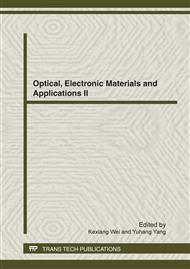p.281
p.285
p.290
p.295
p.301
p.306
p.311
p.318
p.322
Matriptase Sensitive Gold Nanoparticle Probe for early Cancer Detection
Abstract:
Matriptase is a type II transmembrane serine protease highly expressed on the surface of tumor cells and participated in a range of human cancers including those of the breast, cervix, ovaries, prostate, colon and gastrointestinal tract. In this study, we developed a new matriptase detection probe with gold nanoparticles (AuNPs). A fluorescence dye was attached to AuNP surface through the bridge of peptide substrate (GRQSRAC). The fluorescence was quenched due to the fluorescence resonance energy transfer (FRET) between AuNP and the fluorescence dye. The fluorescence recovery properties were confirmed by dithiothreitol in vitro. The result of in vitro cell research indicates that the gold nanoparticle probe is sensitive and specificitive for the detection of matriptase expression in early tumor and has great potential in biomedical application.
Info:
Periodical:
Pages:
301-305
Citation:
Online since:
June 2012
Authors:
Keywords:
Price:
Сopyright:
© 2012 Trans Tech Publications Ltd. All Rights Reserved
Share:
Citation:


